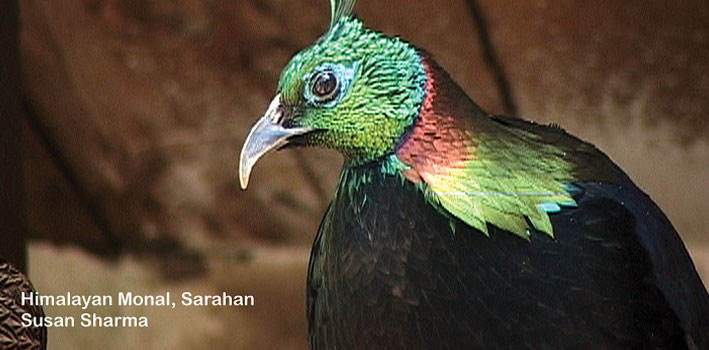WPA Newsletter on the Status of Pheasants in India
-Usha Nair
The conservation of pheasants is a critical aspect of the current global effort to promote biodiversity in the face of increasing onslaught of developmental activities. Pheasants, the large long-tailed “game-birds” (
Are
they game birds or wild birds, vote in our poll), native to Asia, the male of which have very showy plumage, are the subject of interest for the World Pheasant Association. The March 17 newsletter of their Indian chapter, titled "MOR", highlights some
of the concerns of the pheasant conservation activists in India.
Himalayan Monal male by Aditya Chavan @ Chandrashila Tungnath Uttarakhand, April 2017
The newsletter begins with the ground issues unearthed through their week-long field survey, conducted by them around pheasant- rich areas of Dirang and Mandla-Phudung of West Kameng district, under the project “Long Term Conservation of Pheasants in
Western Arunachal Pradesh”, and their disappointment at not being able to sight any pheasant, reportedly because of their displacement of/killing by road construction workers. The sighting of some other birds ,including the rare Black-necked Crane in Sangti
valley, 8 km away from Dirang, partly compensated for the endeavour. The WPA ,in coordination with local NGOs also successfully organised a training event for homestay hospitality and conservation tourism in Rupa (West Kameng district) attended by 73 villagers
from different villages around Rupa.
Other articles covered in the issue include one on the importance of parabiology training to aid the protection of biodiversity; an interesting insight into the descriptions of pheasants contained in the treatises written by Mughal Emperors, Babur and
Jahangir; and a commentary on the Himalayan Monal.
The newsletter carries an article on parabiology, ( a term coined similar to paramedics) which seeks to involve local communities in conservation activities by training them to use ''field instruments such as GPS, camera-traps and radio-tracking to collect
the data, data analysis, and other aspects of applied conservation, such as inventory, patrolling, planning, implementing and evaluating interventions, management decisions, monitoring, awareness, and policy-making'' (Anita Chauhan, author of ‘Conserving Asia’s
Wildlife Treasure: The Pheasants’). She refers to the Gubbi Labs in Gubbi, Karnataka (a private research training organisation), which offers training to help citizen scientists and parabiologists, and forcefully argues for participatory conservation by
local communities to ensure sustainable preservation of threatened pheasants. She opines that ‘conservation is not just a science but also a societal goal'.
The newsletter captures the detailed descriptions and illustrations of birds in the treatises by the Mughal Emperors, Babur, and Jahangir. Babur(1526-1530) is fascinated by the Indian peacock and furnishes extensive pictorial and written details of its
plumage, as also of other birds and animals in his' Baburnama'. Jahangir(1605-1627), his grandson, also has an eye for nature and its magnificent creatures, and in his 'Jahangirnama' gives elaborate details and illustrations of nature's creations, including,
pheasants like, Jan Bahman, the horned pheasant 'Sonlu' and the Himalayan Monal 'Shan’. The newsletter goes on to add that today, the Himalayan Monal is the National Bird of Nepal and the state bird of Himachal Pradesh and Uttarakhand, and provides a detailed
description of its habitat, its food habits, etc. The constant threat of poaching has driven the need to open Monal breeding centres in Uttarakhand Forest Division, Kedarnath Wildlife Sanctuary, Askot and Binsar Wildlife Sanctuary and at Manali.

The Newsletter ends with a tribute to Mr. Duleep Matthai( born in Chennai on 18th October 1924 ; died in Vallabh Vidyanagar, Anand District, Gujarat, on 5th March 2017, aged 92) an environmentalist, a founding trustee of the World Wildlife Fund in India,
a member of important advisory bodies set up by the Government on environment-related issues. Prof M.S.Swaminathan, father of the Indian Green Revolution regarded Mr.Matthai as the father of the ecological security movement in India. Duleep Matthai's Nature
Conservation Trust (DMNCT) was a project sponsor for the publication of MOR, and in his death, India has lost a passionate and visionary environmentalist.
(Usha Nair is a nature lover and can be contacted at ushaenvironment@gmail.com)